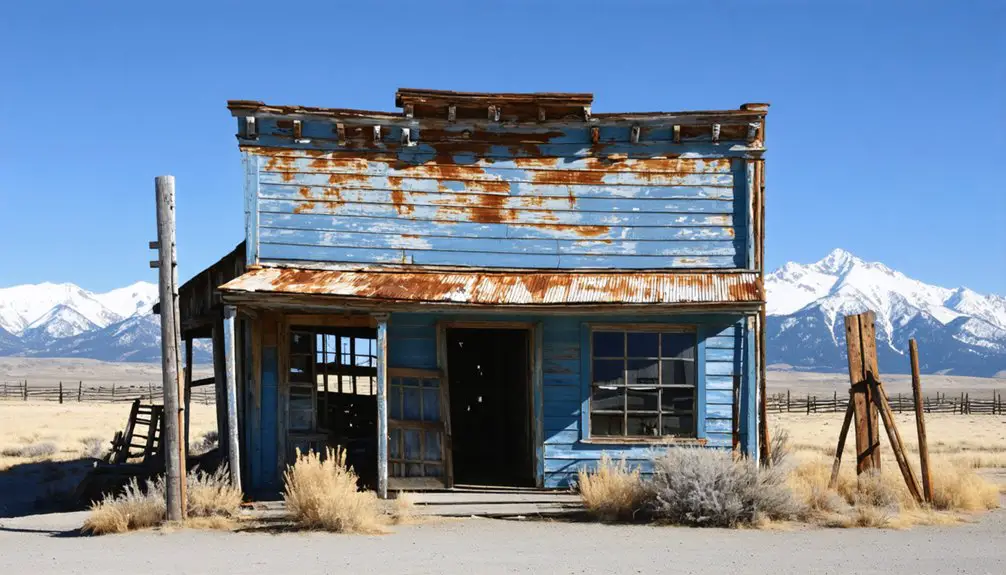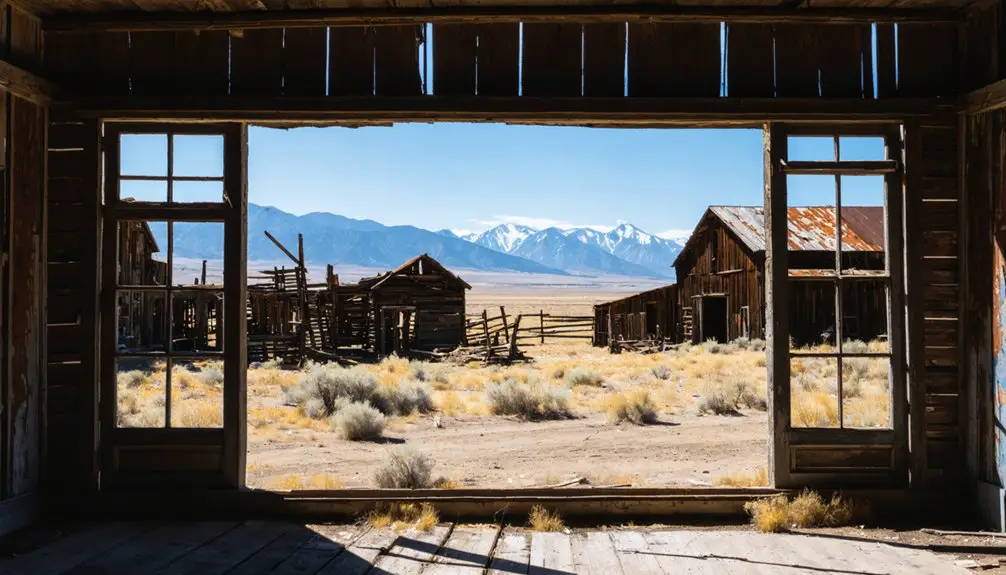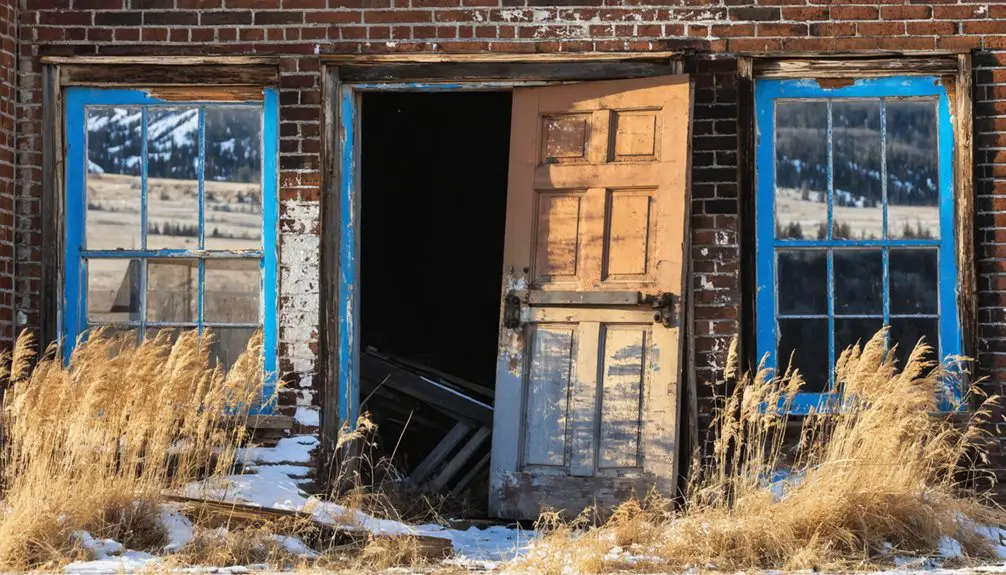You’ll find Electric, Montana‘s fascinating transformation from an 1880s coal mining settlement into a ghost town reflects the state’s early industrial evolution. Originally named Horr, the town became Electric in 1904 when hydroelectric power revolutionized local mining operations. While the community thrived with company housing, stores, and some of Montana’s highest-paid workers, it faced abandonment by 1910 as mining ceased. The town’s ruins tell a complex story of technological progress and industrial decline.
Key Takeaways
- Electric began as Horr, Montana before being renamed in 1904 due to a local power plant’s establishment.
- The town served as a crucial hub for mining operations and hydroelectric power generation in early 1900s Montana.
- Electric was later renamed Aldridge in 1906, focusing on coal and coke mining until operations ceased around 1910.
- The community featured company-owned housing, stores, and offered some of Montana’s highest wages for power plant workers.
- Today, Electric stands abandoned as a ghost town, symbolizing Montana’s industrial past and mining heritage.
The Rise of a Mining Supply Hub
While Montana’s mining towns are often remembered for their ore extraction, Electric emerged as an important power supply hub that helped revolutionize the region’s mining operations.
You’ll find its roots in the pioneering efforts of the Flint Creek Electric Power Company, which in 1891 began developing essential mining infrastructure at Flint Creek Falls. The company’s initial capitalization was $25,000.
The transformation accelerated when the Montana Water, Electric Power and Mining Company took over in 1899, completing critical dam construction and powerhouse facilities by 1901.
The rapid development of Montana’s hydroelectric infrastructure sparked a new era of industrialization under innovative corporate leadership.
Their innovative use of Pelton water wheels to generate hydroelectric power specifically for mining marked a turning point.
This development laid the groundwork for an extensive power network that would eventually connect major mining centers like Butte, Anaconda, and Philipsburg, enabling unprecedented industrial growth throughout the region.
The facility’s success helped establish the foundation for what would become the Montana Power Company in 1912.
From Horr to Electric: A Town’s Evolution
As Montana’s industrial landscape evolved in the early 1900s, the settlement originally known as Horr underwent two significant name changes that reflected its shifting identity.
The town’s industrial transformation mirrored the changing economic forces that shaped the region. The area’s coal veins were first discovered by the Horror Brothers Mining Company in the 1880s. Workers at the mine earned three dollars daily, similar to other mining operations across Montana at the time.
- In 1904, the establishment of a local power plant prompted the town’s first renaming to Electric, marking its evolution from a mining outpost to an energy hub.
- By 1906, the community had incorporated under the name Aldridge, solidifying its town identity as a crucial coal and coke mining center.
- The name changes traced the settlement’s journey from its origins through its peak industrial period, until its eventual abandonment around 1910 when mining operations ceased.
Transportation Innovations and Infrastructure
The transportation landscape of Electric and its surrounding region underwent revolutionary changes during Montana’s industrial boom. You’d have witnessed the groundbreaking railway electrification of the Butte, Anaconda and Pacific Railway in 1911, followed by the Chicago, Milwaukee, St. Paul and Pacific Railroad’s electric line completion in 1917. These innovations transformed mining transport efficiency across the region. General Electric’s pioneering work with the Butte, Anaconda and Pacific helped establish Montana’s leadership in electric railway systems.
Infrastructure development flourished as Montana Power Company expanded its transmission network, with pioneering high-voltage lines connecting major industrial hubs. Modern intercity services like Jefferson Lines now traverse these historic corridors, connecting major cities throughout the state. You’d have seen the integration of coal-fired plants and hydroelectric power supporting this rapid growth.
The rail network’s expansion, particularly through BNSF Railway‘s extensive operations, established vital freight corridors that you can still trace today, though Electric itself would eventually fade as transportation patterns shifted and modernized.
Life in a Montana Coal Town
Life in Electric mirrored the hardships and complexities found across Montana’s coal towns during the industrial age. You’d have found yourself living in company-owned housing, working long shifts underground, and relying on company stores for your basic needs. Like Aldridge’s transition from a small agricultural settlement to an industrial coal town, your community underwent dramatic changes in the 1800s.
Family roles often blurred as everyone contributed to survival, with even children sometimes participating in mining-related work. The power plant workers earned Montana’s highest wages, providing stability for many families in the region.
- You’d have earned your wages through backbreaking labor, facing the constant threat of accidents like the deadly 1904 tram incident.
- During labor disputes, you’d have joined fellow miners demanding better pay and conditions, knowing your livelihood hung in the balance.
- Your social life would’ve centered around communal spaces, where you’d find solidarity with other miners despite ethnic tensions and class hierarchies set by managers and engineers.
The Legacy of Electric’s Mining Era
Mining operations in Electric, Montana left an indelible mark on the state’s industrial development, particularly through its pioneering use of electrical power in coal extraction.
You’ll find that the town’s legacy extends far beyond its operational years, as Montana Power Company’s profits soared threefold during the late 1920s through mining contracts. The company’s strategic shift towards coal mining operations in the 1920s, especially in Colstrip, revolutionized the industry. Like the historic Drumlummon Mine, Electric’s operations significantly impacted the territory’s economic growth.
The impact of Electric’s mining era brought both progress and environmental challenges. While the shift to electrical machinery revolutionized coal extraction efficiency, it also led to significant land alterations and hydrological changes from dam construction.
You’ll notice the economic changes that shaped surrounding communities through mining’s boom-and-bust cycles.
Today, the ghost town stands as a symbol of Montana’s complex relationship with industrial progress, marking an era that transformed the state’s energy infrastructure and set precedents for future mining operations.
Frequently Asked Questions
Can Visitors Safely Explore Electric’s Ruins Today?
Want to explore Electric safely? You can, but you’ll need to follow visitor guidelines like traveling in groups, bringing emergency supplies, and taking safety measures around unstable structures and hazardous debris.
What Wildlife Can Be Commonly Spotted Around the Electric Ghost Town?
You’ll discover remarkable wildlife diversity around the ruins, including mule deer, coyotes, black bears, songbirds, and hawks. Patient observation may reward you with exciting animal sightings in adjacent forests.
How Severe Are Winters in Electric’s High-Altitude Location?
You’ll face brutal winters requiring extensive winter preparations, with temperatures plunging below 0°F, fierce winds, and heavy snowfall. High altitude challenges at 10,969 feet make conditions especially harsh and dangerous.
Are There Any Paranormal Stories Associated With Electric’s Abandoned Buildings?
You’ll find more than just text messages from the past here – Electric’s haunted history includes shadow figures, moving objects, and ghost sightings. EVP recordings capture voices, while witnesses report being watched.
What Archaeological Artifacts Have Been Discovered at the Electric Town Site?
You’ll find mining equipment, ore processing tools, cabin foundations, household items, and ammunition fragments among the 30,000 artifacts. The artifacts analysis reveals integrated community life and significant historical mining operations.
References
- https://www.youtube.com/watch?v=Q8pKSHGds74
- https://www.youtube.com/watch?v=YU0y9_5Ylbg
- https://avrextravel.com/montana-ghost-towns/
- https://en.wikipedia.org/wiki/Aldridge
- https://www.youtube.com/watch?v=xaO_0csHRJk
- https://montanaconnectionspark.com/2018/03/18/butte-ingenuity-powered-montana/
- https://archiveswest.orbiscascade.org/ark:80444/xv02741
- https://bigforkeagle.com/news/2021/sep/08/history-there-wasnt-much-least-there-was-electrici/
- https://archive.legmt.gov/content/Committees/Interim/2019-2020/Energy-and-Telecommunications/Meetings/July-2020/Exhibits/July15/Exhibit1.pdf
- https://mtbeyond.com/history/montana-mining/



